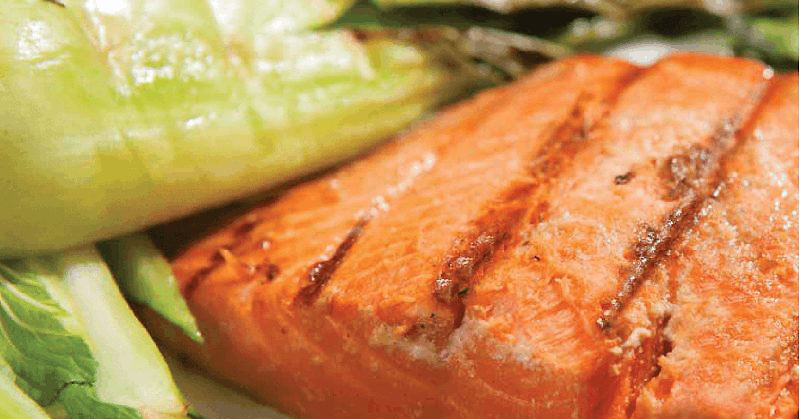
Many people nowadays know that wild salmon has omega-3s. But what exactly does that mean? What’s the big deal about it … are the benefits of wild salmon legit? Chef V explains….
Does Chef V Stand For “Vegan?”
Sometimes people ask me if I’m vegan or if I think being vegan is healthy. Maybe that’s because ChefV.com sells only vegan-friendly products like our famous Organic Green Drink.
The short answer is, no, I’m not vegan. It’s just that, well, it’s a little hard to detox when you’re eating a ton of animal protein. That’s because animal protein is harder to digest. And if the animals are factory-farmed, then it’s laden with toxins.
However, I believe a little animal protein in the diet is healthy. As long as the source is organic/grass-fed/wild/pasture-raised and not factory farmed, animal protein can be part of a healthy, balanced diet.
To my knowledge, there’s never been a traditional society on Earth that was 100% vegan. Every indigenous society throughout history has thrived on at least a minimum amount of animal protein. However, the standard American diet (SAD, indeed) is so unhealthy, it’s no wonder that the vegan lifestyle is becoming more popular.
Why is Wild Salmon Good For You?
As to why salmon is so good for you, it’s all about the omega-3 fatty acids. Omega-3s from wild salmon is one of the healthiest sources of dietary fat. It is part of a diet that may lower triglycerides and improve overall health.
Omega-3s are natural anti-inflammatories. In the western diet, most people eat way too many omega-6s. Although you need some omega-6s, the average ratio of omega-6s to 3’s in the diet is something like 15-20:1. In other words, most people consume about 15-20 times more omega-6s than omega-3s. What should the ratio be? Most nutritionists agree you should not have more than 4 times the amount of 6s than 3s. In fact, the ideal ratio is about 1:1.
What are Omega-6’s?
And why are omega-6s so bad in excess? They can be highly inflammatory. Most processed foods are loaded with omega-6s. That’s because most foods that come in a wrapper include cheap vegetable and seed oils. And these oils are super high in omega-6s.
To make the problem worse, not only are these oils high in omega-6s, they spoil easily. And when you eat vegetable and seed oils (soybean, safflower, cottonseed, corn, canola, etc.) that are rancid, that’s a double dose of inflammation in the body.
Inflammation is good when, let’s say, you get a paper cut. The inflammatory response helps heal. But when inflammation is chronic, it can cause autoimmune disease and a laundry list of other health problems.
Eating wild salmon a few times a week can fight systemic inflammation in the body. And by eating salmon instead of other foods that are high in omega-6s (baked goods, conventional salad dressings, potato chips and other snacky foods and pastries are bad sources of 6’s), you reduce your 6:3 ratio.
Benefits of Wild Salmon
Oh my gosh, where do I even begin? There’s so many health benefits of wild salmon, it’s hard to include them all here in just a blog post. But the important ones to mention include keeping your heart beat rhythm regular. Consequently, wild salmon may cut down your chance of dying suddenly from a heart attack. If there’s a better reason to eat something (especially when it’s as delicious as the recipe I’ll share with you shortly), I don’t know what it is.
Moreover, omega-3s in wild salmon can reduce your chance of getting a stroke. In addition, the fatty acids in salmon can normalize blood pressure and raise your HDL levels. HDL whisks away cholesterol from blood vessels.
Also, there are only a few foods that are relatively high in vitamin D. A serving of wild salmon contains over 100% of your daily value of D. Having adequate blood levels of vitamin D is crucial for a healthy immune system. Salmon is also high in other vitamins and minerals, especially B12, selenium and potassium, just to name a few.
Wild salmon is also good for your brain. There’s lots of research that shows omega-3s can help fight degenerative brain disease. And salmon can also benefit your eyes and joints as well.
The reason why I prefer sockeye salmon from Alaska is that it contains the most amount of omega-3 out of any salmon species. In fact, there’s almost 3 grams of it per serving. I also love the oily, rich taste of sockeye. So unless fishy smell nauseates you, go for sockeye! And there’s even more awesome benefits of wild salmon. But I’ll leave you with just one more. And that is, unlike the vast majority of other seafood, wild salmon is relatively low in pollutants.
Vegan Omega-3s
For these reasons above, I think that it’s good for most people to have a little animal protein every now and then. Especially cold-water oily fish rich in omega-3s like salmon. But if you’re vegan, there’s good news. You can have your omega-3s and eat them, too. In other words, even if you are vegan, you can enjoy the benefits of wild salmon. That’s because salmon are rich in omega-3s because salmon feed on algae. And it’s the algae that’s rich in omega-3s. That means if you’re vegan, you can cut out the middleman, er, fish, and get it right from the source. You can buy algae-oil supplements online or in health food stores.
And keep in mind that although there are plenty of vegan foods that contain omega-3s (flaxseeds for example), plant sources of omega-3s–ALA–are not nearly as strong as the 3’s from fish–EPA and DHA–that feed on algae. So pop those algae oil supplements if you’re vegan. (Or just eat a ton of foods with ALA; ALA does convert into EPA/DHA, although not all of it.)
If you do eat salmon, here are some of my favorite salmon recipes from my cookbook.
